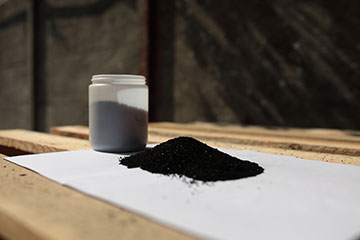Activated carbons


At first glance, all types of activated carbon seem alike. They all derive from the same element, carbon. They are used for their ability to absorb and to remove undesired substances from gases and liquids. However, there are activated carbons which may be more effective depending on the application. Undoubtedly, this is due to numerous factors but determinant is the technical competence of the people involved in optimizing the procedures.
Our main objective has been to single out from amongst the various categories of carbons, those which are more suitable to a particular application, experimenting with powdered or granular products activated physically or chemically, successfully obtaining the most appropriate alternative. Even the experience we have gained from helping customers to individualize the best solutions to their problems has been determinant. We can safely state that our competency in resolving any type of problem of adsorption is indisputable.
Greater adsorption capacity, better product quality
Activated carbons are chemically inert industrial products (essentially composed of carbon), with a highly developed porous structure. They have a very large surface area providing superb conditions for adsorption to occur in comparison to a number of other substances. In general, the pore volume is superior to 0.8 ml/g and the surface area is superior to 1000 m²/g. Pores have variable dimensions and are classified into three categories:
- Macropores: Macropores have a diameter superior to 500 Angstrom. Not all of their pore volume may be available for adsorption and therefore, they do not have a high adsorption capacity.
- Mesopores: Mesopores are also known as transition pores and have a diameter between 30 and 500 Angstrom. They are the main means of access and have a fundamental role in adsorption kinetics.
- Micropores: Micropores have a diameter between 5 and 30 Angstrom. They are the essential and active part of the surface area.
Adsorption is the adhesion of molecules in a dissolved phase (liquid or gaseous) to the surface area of a solid. This process creates a film of adsorbate (the molecules or atoms being accumulated) on the surface of the adsorbent. It is a consequence of a field of attraction, of surface energy. The forces that bring about the binding of molecules to the surface of carbon are relatively weak. They are "Van Der Waals forces" and create, after a given length of time, an equilibrium dependent on the temperature and the composition of the molecules in their liquid or gaseous phase. We can define the "isotherm of adsorption" as the curve that represents, at a constant temperature, the quantity of substances adsorbed by the carbon in function of the concentration of free molecules, in the fluid, in contact with the adsorbent material.
Physically activated carbons
Physical activation is generally used for the activation of material with carbon content such as coal, nutshells (coconut), and wood. This material undergoes a process of carbonization at temperatures in the range of 800°C-1000°C in a controlled atmosphere in the presence of steam. In this way, the gas released can be burnt off without burning the carbon.
Activated carbons with primarily meso and micropore structures are obtained. These are ideal for the removal of pollutants found in both liquid and gaseous phases.
Chemically activated carbons
Chemical activation is a one-step process which gives way to thermal decomposition of the raw material without pre-carbonization. It is done at a temperature ranging from 500 to 600°C, in the presence of a dehydrating and oxidizing agent such as phosphoric acid or zinc chloride.
The average diameter of carbon pores that are chemically activated is greater than those that are physically activated, a fundamental characteristic for decolourization processes where the molecules of adsorption are a larger size.
Quality control
Activated carbons are complex and are difficult to classify on the basis of their various properties (behaviour, surface characteristics, and preparation methods). The following three groups are the means of analysis with which activated carbons can be classified:
Morphological characteristics
Granulometry: The measurement of the size of the grains and their granulometric classification is achieved via classical methods of wet or mechanical sieving or via laser.
Volumetric mass: The measurement of a unit of mass under standard conditions. This does not depend solely on the quality of the carbon: it varies with the granulometry and how the grains are arranged and compacted onto the surface area.
Porosity: The measurement of the surface area of the carbon and the classification of the pores in function of their diameter.
Chemical-physical characteristics
Humidity: The measurement of the loss of weight due to oven drying if water is the only volatile compound present, otherwise a distillation method with xylene is used.
Ash content: The measurement of residual inorganic substances after calcination of carbon (total ash content) and of those substances that solubilise when treated with acids (acid/water soluble ash content).
PH: The measurement of the pH of water treated with carbon under standard conditions. This is dependent on the activation system used and on the chemical nature of the radicals found on the surface area.
The adsorption properties are represented by indexes (numbers) which express the adsorption potential of the carbons in relation to the various sizes of molecules. There is a correlation between these indexes and the porous structure of the carbon.
Molasses Number: This is a measurement of the mesopore content of the activated carbon. The colorization of the molasses derives from molecules ranging in size from 30 to 100 Angstrom. This measurement has met favourably with various applications typical of activated carbon, in particular, with decolourization processes of primary products in the chemical-pharmaceutical industry.
Iodine Number: This is a measure of the micropore content of the activated carbon. Size ranges from 5 to 15 Angstrom. The Iodine molecule is of small dimensions and therefore, accessible to all of the carbon's porosity. This test gives an indication of the surface area of the carbon only if there is nothing present prone to interact with the Iodine.
These sets of analytical tests give only a partial view and must be interpreted with caution. Only the Isotherm of Adsorption points out the quality of an activated carbon in relation to the application being considered.
Isotherm of Adsorption
There are a number of empirical formulas which represent the phenomena of adsorption. In regards to adsorption in a liquid phase, the relationship between the amount of adsorbate and the amount of carbon used is defined by Freundlich's isotherm. In a graph based on a logarithmic scale, the isotherm is represented by a straight line with a slope 1/n.
Bleaching earths
Bleaching earths are mainly used to remove chromophore substances. But this is only one of the several applications of these filter media used to solve problems like for example the purification of animal fats.
Bleaching earths, such as the active carbons, are divided into:
- chemically activated bleaching earths
- physically activated bleaching earths
depending on the activation process they are subject to.
The average pH value of chemically activated bleaching earths is usually 2-3, while those physically activated are more alkaline with a pH usually above 7.
Bleaching earths are mostly made up of single substances like attapulgite, montmorillonite, sepiolite, clinoptilolite or a combination of them; the original clays contain above all silica and alumina and possible traces of iron, magnesium, calcium and potassium. Clay deposits look similar to the ground, can be brown or light brown, yellow or pure white.
Activation systems
Although these clays already are characterized by their own excellent adsorbent properties, they are also subject to special treatments that strenghten this feature.
Chemical activation
The activation process with sulphuric acid and hydrocloric acid allows to remove several ions from active sites that get ready for adsorption of impurities: the various types of ions (Ca, Mg, Fe, K) are homogeneously dispersed in the Si-Al clay matrix.
The acid activated earths are able to remove chlorophyll, carotenoids and other compounds like phosphorus or oxidation compounds from food oils, minerals oils or fats.
Physical activation
The physical activation process is triggered by heating the clay up to about 600°C inside a rotary oven to clear the porous structure that is typical of this material.
The attapulgite and the sepiolite are the most suitable clays for this type of process. Also the physically activated earth is able to remove chlorophyll, carotenoids and other compounds like phosphorus or oxidation compounds from food oils, minerals oils or fats.
Granulometry
A fundamental parameter of the bleaching earths, the basic or the acid ones, is the granulometric distribution. Actually, besides being able to remove the chromophore substances (chlorophyll, carotenoids, etc.), they must have such a granulometry that does not limit the filtering process.
Different types of granulometric distribuitions can be obtained by special grinding processes, according to market's requests: some bleaching earths allow to work with higher filtering speeds.
Diatomaceous earths
Diatomaceous earths, also known as fossil flours, derive from the fossilized remains of diatoms, a type of protist with a silica exoskeleton, which live in saltwater lakes and oceans.
Deposits of fossilized diatoms are found mainly in dried-up ancient saltwater lakes in certain geographical areas, where the raw materials used for the production of fossil flours are extracted.
Diatomaceous earths are ideal for use as a filtration aid for the removal of the solids suspended in liquids. Their great versatility means they can be used in various applications, ranging from water purification and treatment to filtration of liquid foods and applications in the chemical and pharmaceutical industries.
They are divided into three great families, depending on the degree of processing needed for their production:
- Natural (ochre) ideal for use in the zootechnical industry and in filtering liquid foods (beer, wine, oil, sugars etc.);
- Calcined (pink) largely used for filtering liquid foods (beer, wine, oil, sugars etc.), in chemical industry products (citric and phosphoric acids etc.) and in the mineral oils industry (lubricants and additives);
- Flux calcined (white) used for filtering liquid foods (beer, wine, oil, sugars etc.), chemical industry products (citric and phosphoric acids etc.), and in the mineral oils (lubricants and additives), pharmaceutical (alginates, antibiotics) industries and medical (blood and plasma) industries.
Privacy Policy |Cookies Policy
© 2017 Carbonitalia S.r.l. | C.F. e P.IVA: IT01556150496 | Design by Afterbit

